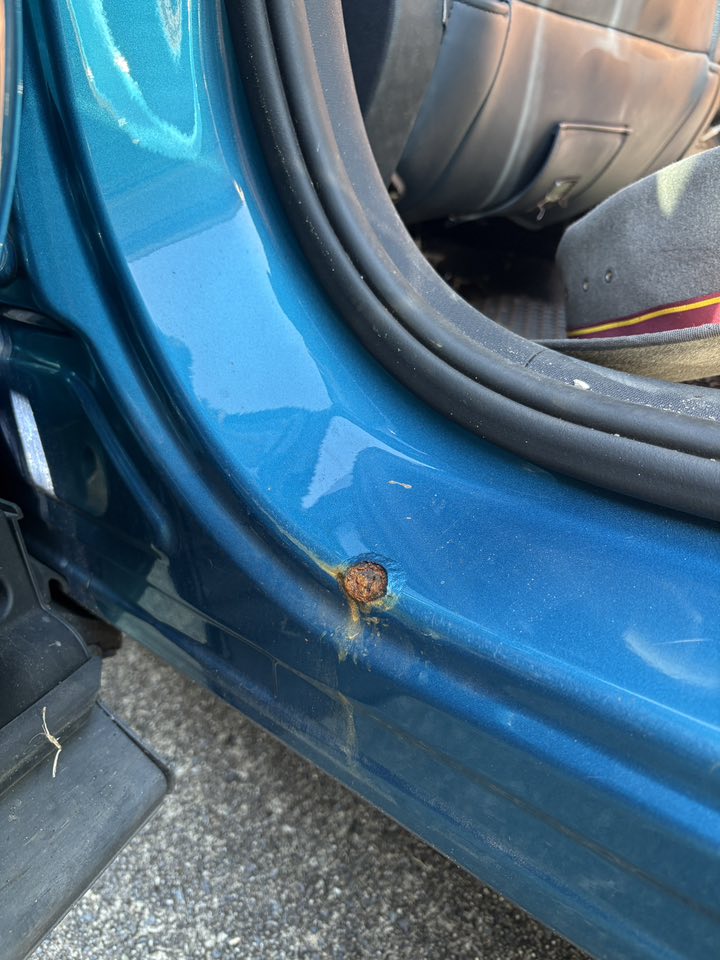
BYD is rapidly becoming a giant in the Australian auto industry. Recently, the sales of the Shark 6 pushed BYD into the #6 position. So, after an Australian BYD owner posted on Facebook that she was having rust issues with her relatively new BYD Atto 3, I sought further feedback from the group. Many expressed their satisfaction with their cars, and queried the rust.



How had the rust formed, they mused? There were quite a few conjectures, all answered by the original poster. After 80 comments back and forth, the consensus formed that it was more than likely an issue caused by poor metal preparation prior to painting. The subsequent advice was: “That shouldn’t happen on properly galvanised cars, get some independent advice from a certified repairer and then present it to BYD with a request for repair under warranty.”
Some possibilities about the cause of the rust ranged from paint exposed due to stone chips; car parked near the ocean; a seatbelt slammed in the door; paint scratched by handbags, jeans, shoes with metal attachments/buttons. My favourite was that the rust could have been caused by corrosive bat poo? Only one responder said they had a similar issue and posted a picture of their rust spot. “I had a tiny bit of rust on a very early model, and they fixed it no argument (just took a while for the approval to come through).”

I posted that I would like to do an article on the rust issue and got many comments from drivers, affirming their satisfaction with the BYD Atto 3 and the lack of rust.
- “2-year-old Atto 3, no rust. I live next to ocean, within 50 meters and the Atto is always outside. 4-month-old Shark, parked the same, also no rust.”
- “2 years old Atto, 1 year SL6, no rust.”
One queried whether I was also going to write about the rust problems in petrol cars, or perhaps Tesla. Are we being a little defensive, perhaps?
The positives continued:
- “2.5-year-old Atto no rust.”
- “2 years old Atto 3 no rust.”
- “2.5 year Atto no rust parked at beachfront — my 2.5 year atto has no rust what so ever, every summer day parked less than 100 m away from the beach.” Lucky fellow! Surf’s up!
Back to the original rust problem, the owner has now taken the car back to BYD and been advised that they will book it in for a diagnostic as part of their warranty procedures. She has been told to get a quote from a smash repair business to rectify the issues. Things are looking good. Looks like BYD will come to the party. However, she would prefer a replacement, as there may be other hidden issues from lack of treatment of the car’s metal.
The same issue has also surfaced in New Zealand. One owner has experienced corrosion at the site of paint damage caused by stone chips. This is understandable when using unsealed roads. But rust is coming through on door panels that were not damaged by road debris. He also posted on Facebook and got a response from BYD. “The response from BYD then became very prompt, with BYD contacting myself and the dealer to action a warranty claim.”
A local paint and panel shop stripped down the bonnet, front wings, a door, the windscreen surround, and the A pillar to bare metal. Most of the car was repainted. He estimates that the job would have cost around NZ$7,000 (US$4,157), with BYD footing the bill and insisting on a proper job. Even the country manager got involved, admitting that some cars from early consignments were not prepared as well as they might have been. Adding: “Customers can have confidence in our fully transferrable six year /150,000km bumper-to-bumper warranty.”
BYD claims that their cars are “manufactured to the highest global quality standards and that the process undertaken when rustproofing during production was of the highest global standards utilising the latest technological processes. BYD uses electro-galvanising, which produces a thin, uniform layer of zinc coating that provides corrosion resistance to the underlying metal.”
So far, these rust issues are few and far between and I expect that they will be addressed as well in Australia as they have been so far in New Zealand. BYD has a lot riding on customer satisfaction and loyalty as they expand rapidly in the Southern Hemisphere. In Australia, BYD is outselling Tesla if you count all their plug-in models. Currently for sale in Australia, we have the Dolphin (BEV), Seal (BEV), Sealion 6 (PHEV) and Sealion 7 (BEV), Shark 6 (PHEV), and Atto 3 (BEV). BYD expects to release more models next year (Atto 2, Sealion 8) and may then challenge Tesla on all-electric numbers.
The more electric cars on the road, the better for all.
Sign up for CleanTechnica’s Weekly Substack for Zach and Scott’s in-depth analyses and high level summaries, sign up for our daily newsletter, and follow us on Google News!
Have a tip for CleanTechnica? Want to advertise? Want to suggest a guest for our CleanTech Talk podcast? Contact us here.
Sign up for our daily newsletter for 15 new cleantech stories a day. Or sign up for our weekly one on top stories of the week if daily is too frequent.
CleanTechnica uses affiliate links. See our policy here.
CleanTechnica’s Comment Policy
cleantechnica.com
#BYD #Atto #Rust #Issues #BYD #Responds #Promptly





